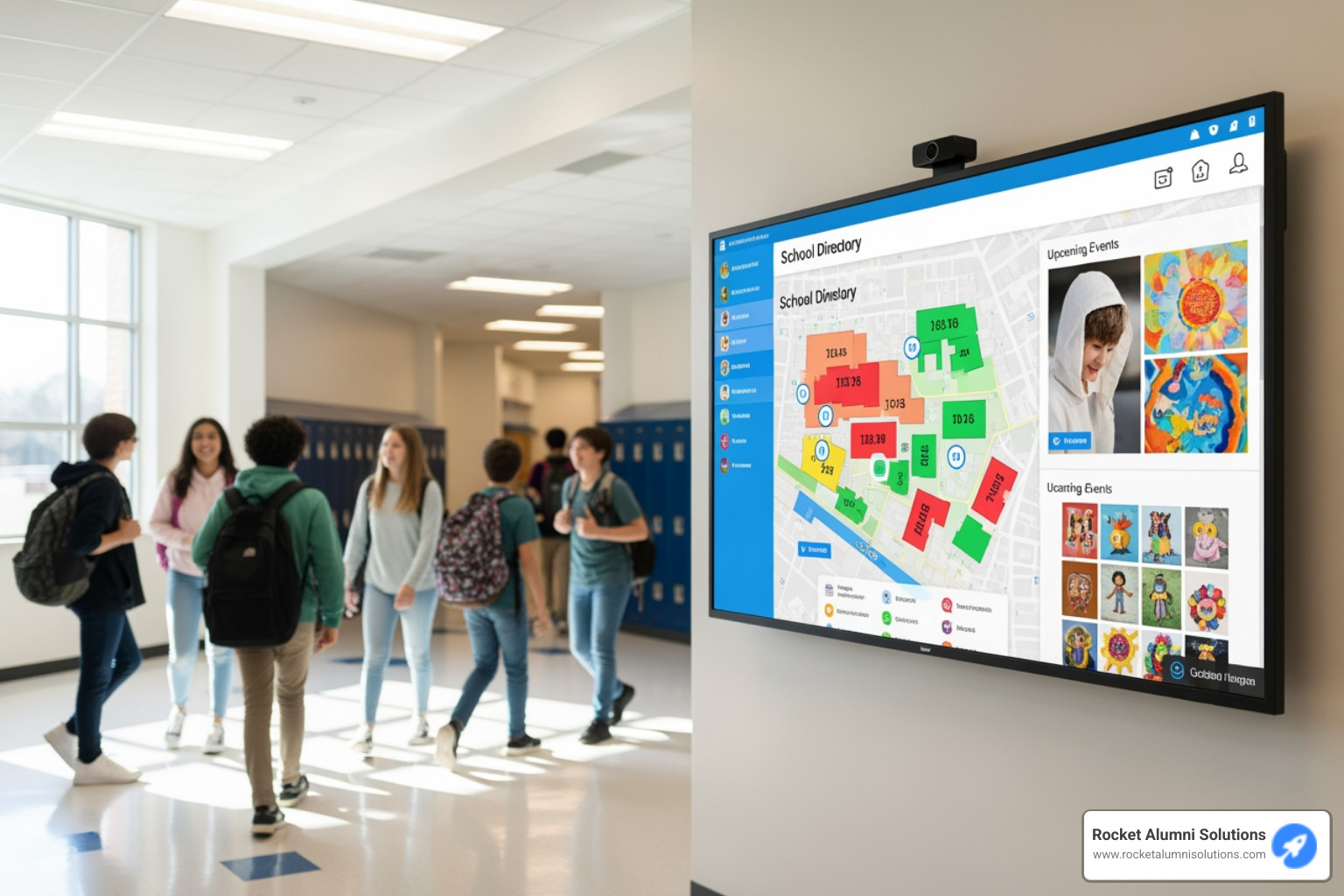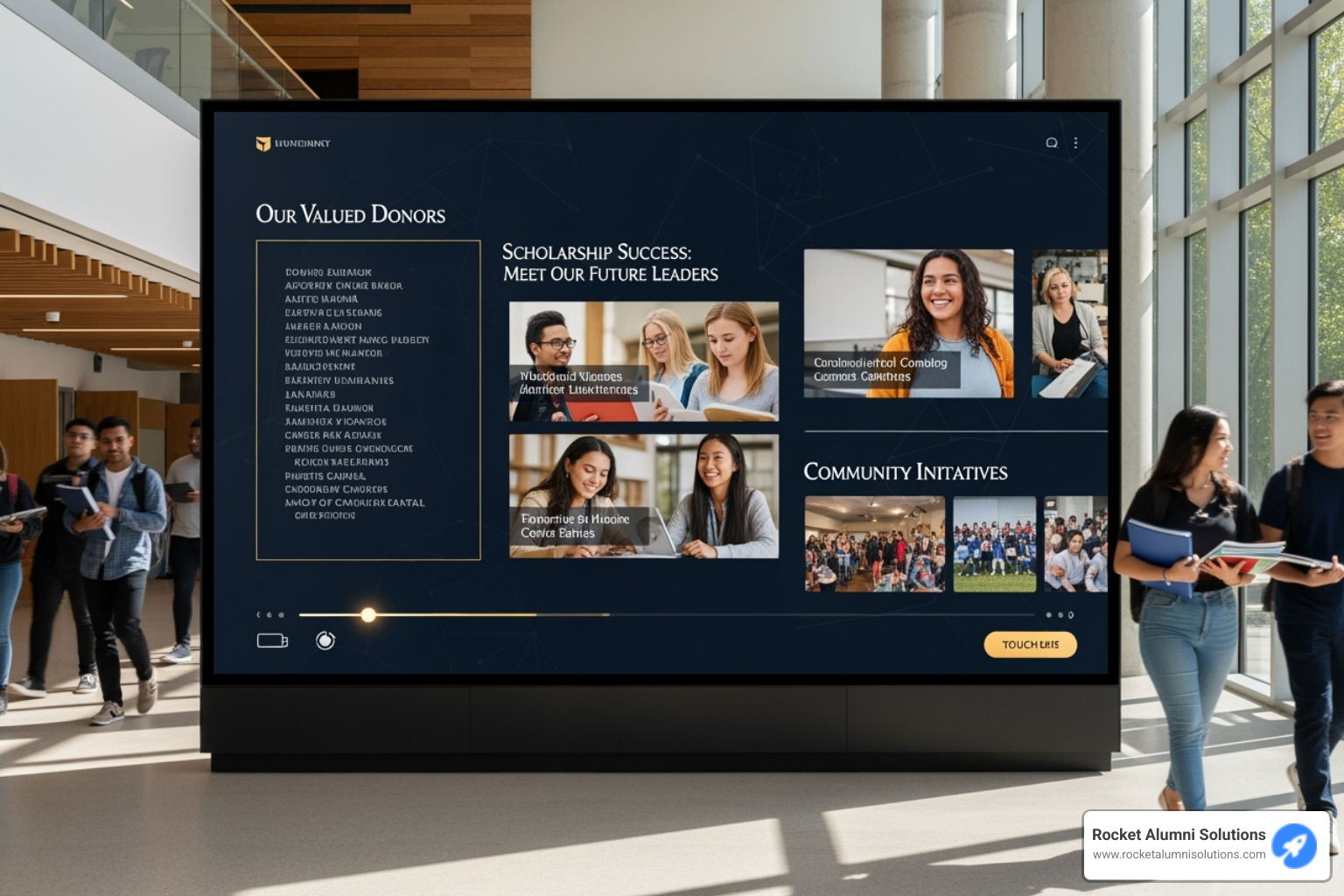The Digital Front Door of Modern Senior Care
Assisted Living Kiosk technology is changing how senior care facilities operate, serving as digital front doors that streamline visitor management, improve security, and improve resident experiences. These interactive touchscreen systems automate traditional paper-based processes while providing new ways for families to stay connected with their loved ones.
Key Functions of Assisted Living Kiosks:
- Visitor Management: Automated check-in/out with instant badge printing
- Security Improvement: Real-time monitoring and access control
- Health Screening: Temperature checks and health questionnaires
- Resident Engagement: Activity calendars, communication tools, and entertainment
- Dining Services: Menu displays, meal ordering, and nutritional information
- Emergency Preparedness: Real-time evacuation lists and mass notifications
The pandemic accelerated adoption dramatically. 80% of senior housing professionals surveyed indicated their facilities increased their tech budget to address operational challenges. This shift reflects a broader recognition that technology can solve real problems in senior care.
Traditional visitor check-in required multiple staff members and created bottlenecks. Modern kiosks eliminate these pain points while adding capabilities that weren't possible with paper logs. They can verify credentials, screen for health risks, and even help combat social isolation among residents.
The benefits extend far beyond efficiency. Facilities using advanced kiosk systems report significant improvements in Google reviews and resident satisfaction. Some communities have seen their online ratings increase by nearly 300% after implementing comprehensive kiosk solutions.
I'm Chase McKee, founder of Rocket Alumni Solutions, where I've helped communities nationwide implement interactive touchscreen technology that transforms how organizations connect with their stakeholders. Through our work with healthcare and senior living facilities, I've seen how Assisted Living Kiosk systems can revolutionize both operations and resident experiences.
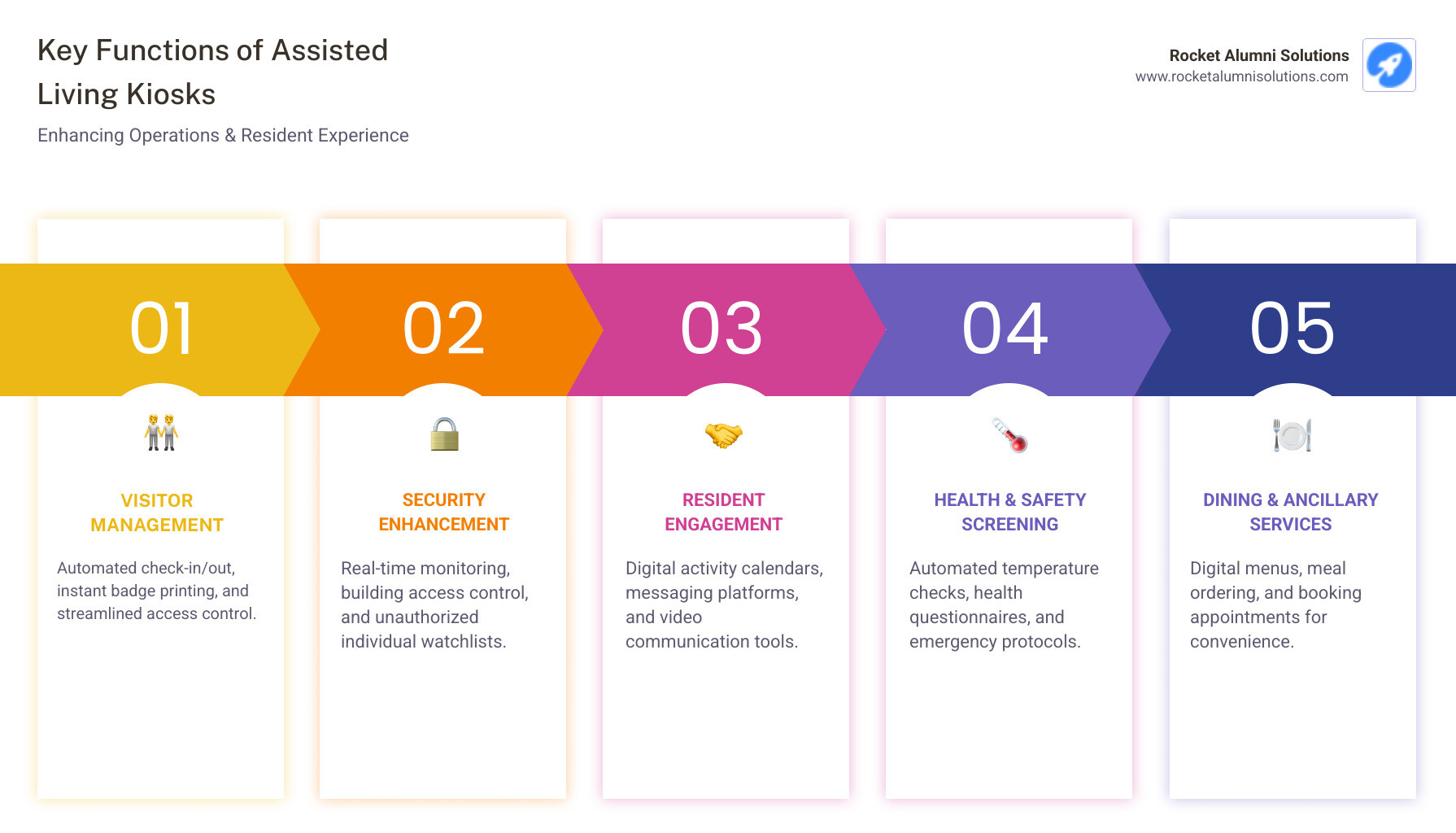
Simple Assisted Living Kiosk word guide:
Core Functions of an Assisted Living Kiosk: Enhancing Safety and Efficiency
When I visit assisted living communities, I often see front desk staff juggling multiple tasks at once - checking in visitors, answering phones, and managing security protocols. It's no wonder that Assisted Living Kiosk systems have become such game-changers in senior care. These digital solutions tackle the daily challenges that consume valuable staff time while significantly improving safety and security.
The change is remarkable. What once required multiple staff members and stacks of paperwork now happens seamlessly through automated systems. Visitor management becomes effortless, staff workloads decrease dramatically, and security protocols get stronger. Most importantly, these improvements free up your team to focus on what truly matters - caring for residents.
The shift toward technology in senior housing isn't just a trend. It's a response to real operational needs that became especially clear during recent years. For facilities looking to understand the full scope of benefits, our Assisted Living And Nursing Home Touchscreen solutions offer comprehensive insights. The healthcare industry has seen similar changes, as outlined in this resource on Patient Kiosks in Healthcare – Top 5 Reasons to Use.
Streamlining Visitor and Staff Management
Picture this: instead of visitors waiting in line at a busy front desk, they walk up to a sleek touchscreen and complete their check-in in under two minutes. That's the power of automated check-in and check-out systems. The Assisted Living Kiosk handles the entire process, from registration to instant name tag printing, creating a smooth first impression while reducing bottlenecks.
The health screening capabilities are particularly valuable. Visitors can complete health screening questionnaires right at the kiosk, answering questions about recent symptoms or potential exposures. Advanced systems even include temperature scanning, adding an extra layer of protection for vulnerable residents. Once visitors are checked in, they can use features like our Kiosk Directory to steer the facility confidently.
For facilities managing third-party caregivers, the benefits multiply. Third-party caregiver credentialing becomes automated, with the system verifying employment status, criminal background checks, required immunizations, and insurance coverage. This level of oversight was nearly impossible to maintain consistently with manual processes.
Staff appreciate the staff timekeeping features too. Clock-in and clock-out become simple touchscreen interactions, eliminating time cards and reducing payroll errors. But perhaps most critically, these systems excel in evacuation management. During emergencies, administrators can instantly access real-time accountability lists showing exactly who's in the building - residents, staff, and visitors. This capability has proven invaluable during natural disasters and other crisis situations.
Bolstering Community Security and Safety
Security concerns often top the list when families choose an assisted living community. An Assisted Living Kiosk addresses these concerns head-on by monitoring building access with precision that manual systems simply can't match.
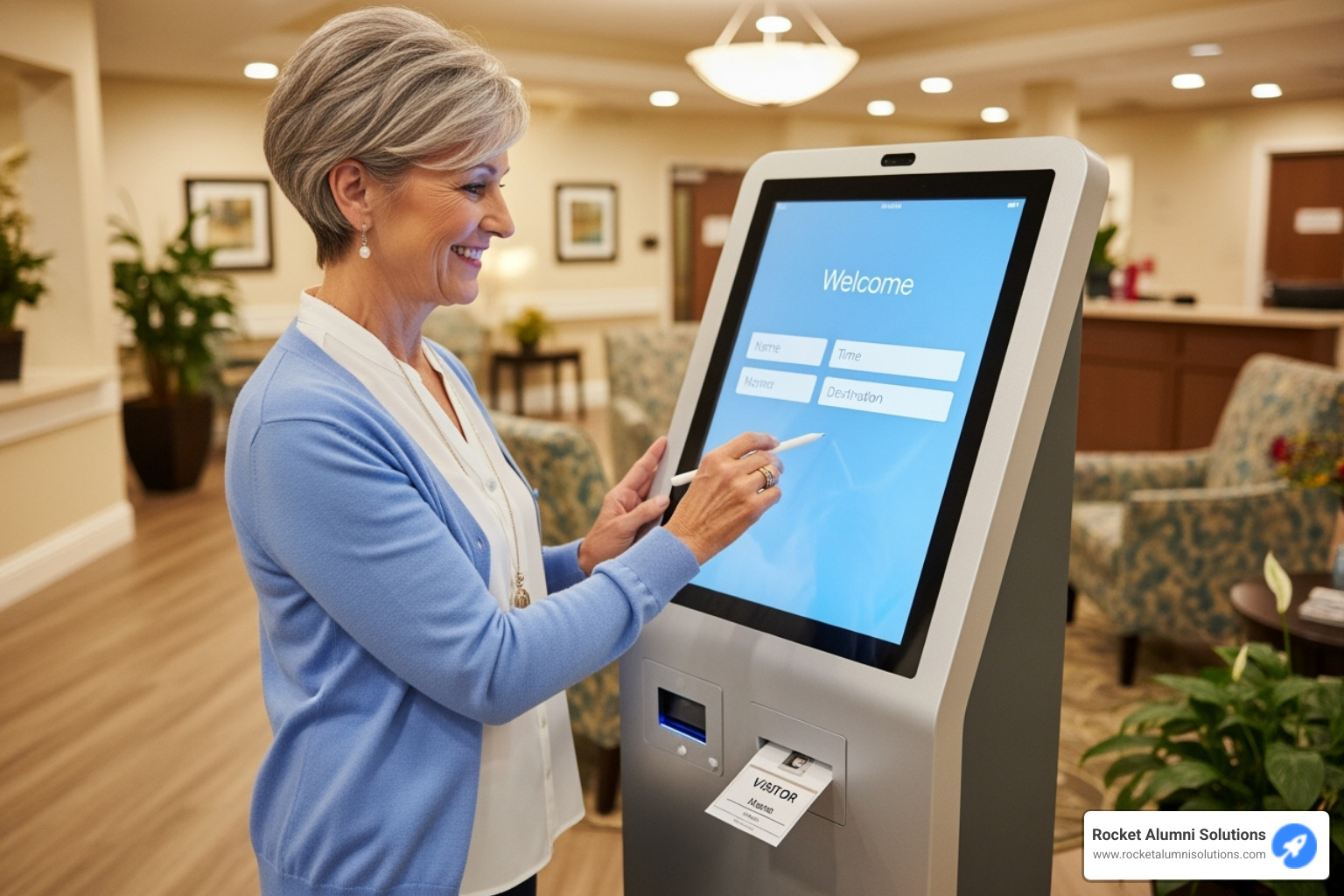
The system maintains watchlists for unauthorized individuals, automatically flagging anyone who shouldn't be in the facility. This proactive approach prevents security issues before they start. All data collection follows HIPAA-compliant standards, ensuring that sensitive health information and personal details remain protected.
Documenting consent for policies becomes seamless too. Visitors can review and digitally agree to facility guidelines, from visiting hours to health protocols. This creates a clear audit trail while ensuring everyone understands the rules.
During emergency preparedness situations, the kiosk's real-time occupancy data becomes invaluable. Administrators know immediately who needs to be accounted for during evacuations or other emergencies, a feature that greatly improves the ability to respond quickly in a crisis.
The peace of mind these systems provide extends to families, staff, and administrators alike. When security protocols run smoothly in the background, everyone can focus on creating a warm, welcoming community environment.
The real magic of modern Assisted Living Kiosk systems happens when they move beyond simple visitor check-ins. These advanced features transform entire communities by creating deeper connections, streamlining daily life, and building lasting relationships between residents, families, and staff.
Think of these kiosks as the heart of your community's digital ecosystem. They seamlessly integrate with your existing systems - from electronic health records and customer management platforms to dining services and activity calendars. This connectivity creates a smooth, personalized experience that touches every aspect of community life.
The change goes far deeper than efficiency gains. Advanced kiosks actively combat one of senior care's biggest challenges: social isolation. They revolutionize how residents connect with loved ones, participate in activities, and engage with their community. Plus, they can significantly boost your facility's reputation by making it easier for satisfied families to share their positive experiences online.
For communities ready to accept this technology, Interactive Touchscreen Displays offer endless possibilities for enriching resident experiences.
Key Advanced Integrations:
- Health Records: Access resident profiles for personalized care delivery
- Customer Management: Track inquiries and streamline admissions processes
- Dining Systems: Connect menus, dietary needs, and meal preferences
- Activity Calendars: Display events and enable easy sign-ups
- Credentialing: Automate verification for visiting service providers
- Reputation Platforms: Collect feedback and encourage positive reviews
Fostering Connection and Combating Social Isolation
One of the most heartwarming impacts of advanced Assisted Living Kiosk technology is how it brings families together, even across great distances. These systems recognize that staying connected with loved ones isn't just nice to have - it's essential for resident wellbeing.
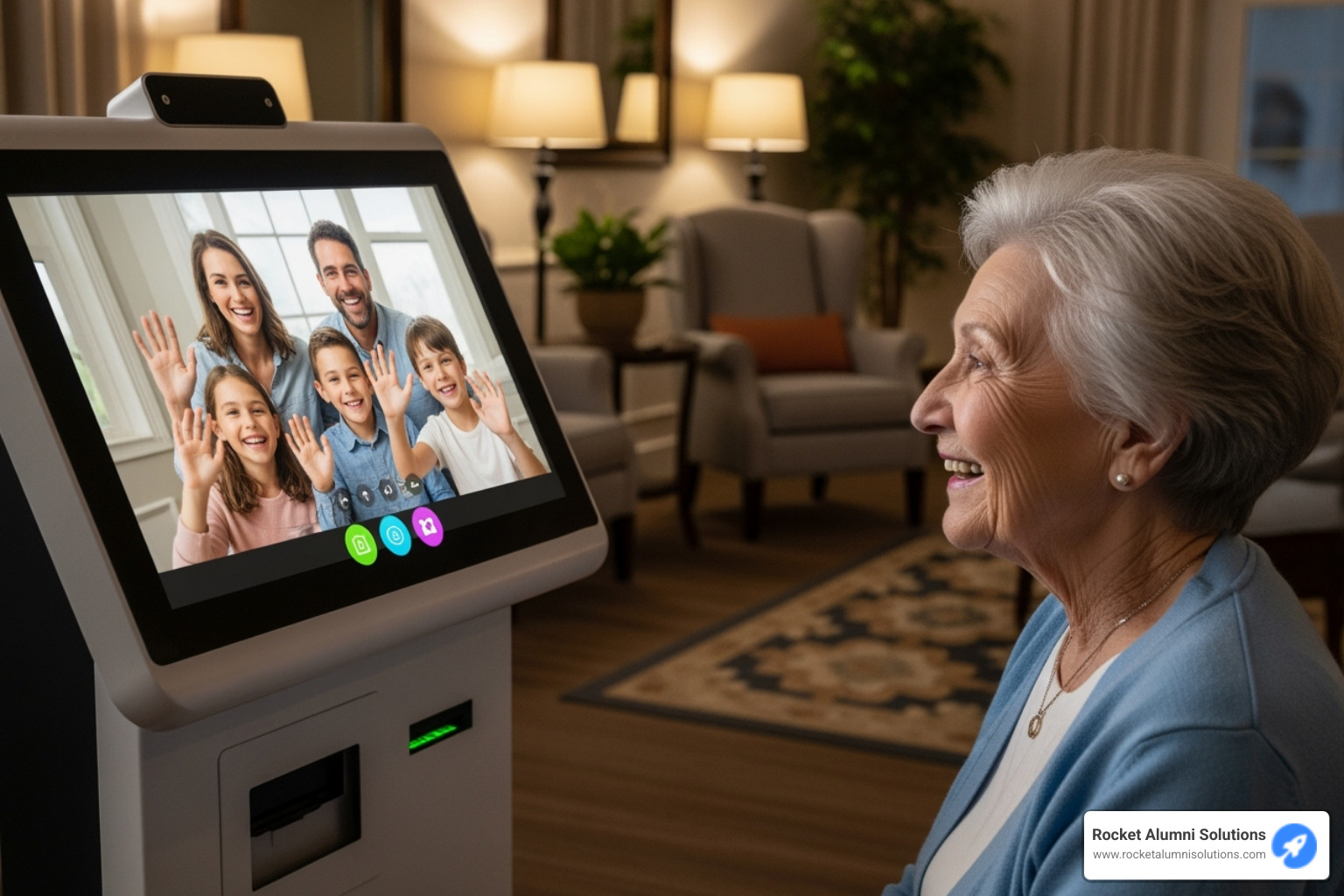
Digital activity calendars make it simple for residents to see what's happening each day and sign up for events that interest them. This puts control back in their hands, encouraging active participation in community life. Our Touchscreen Calendar for Senior Living solutions make this process intuitive and engaging.
The communication features are where these systems truly shine. Photo and video sharing lets families send precious memories directly to the kiosk, where residents can view them whenever they want. Some systems include messaging platforms and video chat capabilities, enabling spontaneous conversations that brighten residents' days.
For example, some systems are designed with large, colorful buttons and easy-to-read text, making them accessible for residents to use independently. These thoughtful designs, which can even include physical keys for simple access, prove that technology can be both sophisticated and user-friendly.
Perhaps most importantly, some innovative facilities use visitor data to identify residents who might need extra social connection. These insights can connect less-frequently-visited residents with volunteer programs, ensuring everyone receives the attention and interaction they deserve. Learn more about these possibilities through our Community Engagement Touchscreen Solutions.
Revolutionizing Dining and Ancillary Services
Mealtime should be one of the day's highlights, and Assisted Living Kiosk technology lifts the dining experience to something resembling a luxury cruise ship's level of service and convenience.
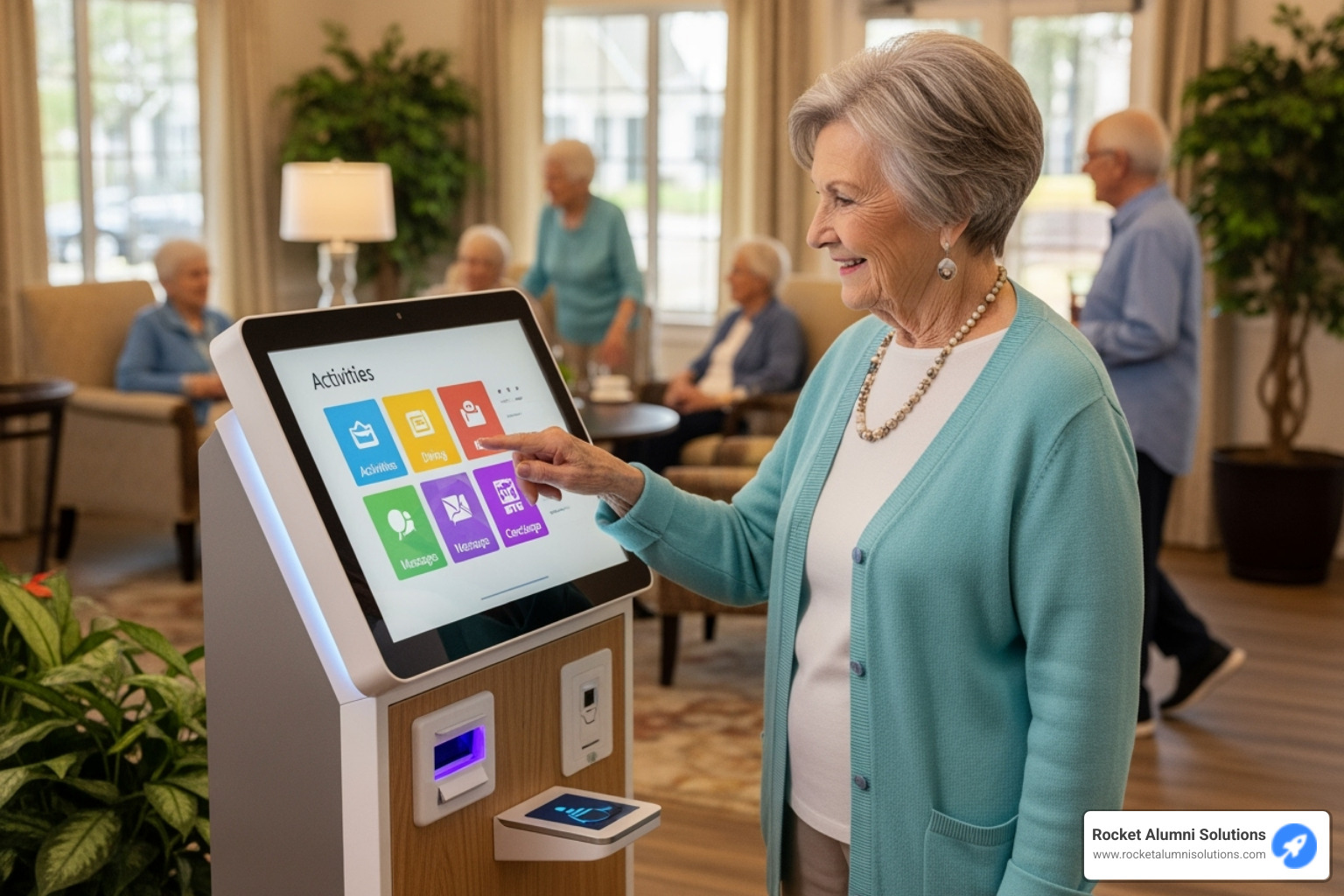
Self-ordering through kiosks empowers residents to browse daily menus, review nutritional information, and place orders independently. The system can integrate allergy alerts and dietary restrictions, ensuring residents only see appropriate meal options. This personalized approach makes dining safer and more enjoyable.
The convenience extends throughout the community. Kiosks integrate with point-of-sale systems for bistros, cafes, and gift shops, creating a seamless experience. Residents can use their badges for purchases or have costs automatically deducted from accounts, eliminating the need to carry cash or cards.
Staff benefit tremendously too. Electronic orders transmitted directly to the kitchen reduce miscommunication and free up team members to spend more time interacting with residents rather than taking orders manually.
Beyond dining, these versatile systems handle appointment booking for salon services, fitness classes, and spa treatments. They can even process product sales for these services, creating a comprehensive amenity management system. Our Intelligent Digital Calendar Solutions can further improve these scheduling capabilities.
Boosting Your Facility's Reputation
Your facility's online reputation directly impacts occupancy rates and family satisfaction. An Assisted Living Kiosk acts as a powerful reputation accelerator, systematically gathering feedback and encouraging positive online reviews at exactly the right moments.
Automated feedback collection integrated into check-in or check-out processes captures real-time sentiment from visitors and family members. When feedback is positive, the system can seamlessly guide users to leave reviews on Google, Facebook, or other platforms where potential residents research communities.
The results speak for themselves. One senior living provider, for example, experienced a remarkable 289% increase in Google reviews, achieving an average rating of 4.84 stars in just six weeks using their kiosk system. Facilities typically see an average of 7.1 Google reviews per month through these systems, with an average rating of 4.6 stars and over 90% positive ratings.
Beyond reviews, kiosks showcase positive testimonials and offer virtual tours for prospective residents. This creates a modern, transparent image that builds trust with families researching your community. Explore our Touchscreen Kiosk Virtual Tour and Transformative Community Engagement Healthcare solutions to see how this works.
By automating routine tasks, kiosks free front desk staff to provide more personalized service and immediate assistance to visitors. This improved attention contributes to positive experiences that naturally lead to better reviews and stronger community reputation.
Implementation and Future Trends for the Assisted Living Kiosk
Planning to implement an Assisted Living Kiosk system? You're making a smart move that goes far beyond just adding new technology. This is about creating a more connected, efficient, and welcoming environment for everyone who walks through your doors.
The key to successful implementation lies in focusing on accessibility and user-friendly design. Your kiosk needs to work for everyone - from tech-savvy family members to residents who might be using touchscreen technology for the first time. That means large, clear buttons, simple navigation, and interfaces that feel intuitive rather than intimidating.
Looking ahead, the future is incredibly exciting. AI integration is changing how these systems work, moving from simple touch-and-respond interfaces to intelligent assistants that can anticipate needs. Personalization is becoming the norm, with systems that remember preferences and adapt to individual users. Meanwhile, data analytics are helping facilities understand patterns and improve services in ways we never imagined possible.
If you're curious about what's coming next, take a look at our AI Powered Digital Kiosk solutions to see how artificial intelligence is reshaping the entire experience.
Selecting the perfect Assisted Living Kiosk for your community feels a bit like choosing a new car - there are lots of options, and the right choice depends on your specific needs and goals.
Hardware considerations matter more than you might think. You'll want durable equipment that can handle daily use by people of all ages and abilities. Screen size should be large enough for easy reading, and the touch technology needs to be responsive without being overly sensitive. Some facilities prefer wall-mounted units to save space, while others choose freestanding kiosks that can be moved as needed.
Software flexibility is where things get really interesting. The best systems work across different operating systems and don't require coding knowledge to update content. This means your staff can make changes and improvements without calling in technical experts every time you want to update a menu or add a new activity.
Integration capabilities with existing systems can make or break your investment. Your kiosk should talk seamlessly to your dining management software, resident databases, and security systems. When everything works together, you eliminate duplicate data entry and create a smoother experience for everyone.
Don't underestimate the importance of staff training. Even the most user-friendly system needs champions on your team who understand how it works and can help others feel comfortable using it. Plan for comprehensive training that goes beyond just the technical aspects to include customer service approaches.
Ongoing support from your vendor makes all the difference. You want a partner who responds quickly when you have questions and provides regular updates to keep your system current and secure.
| Feature/Kiosk Type | Visitor Management System | Resident Engagement Hub | All-in-One Comprehensive Solution |
|---|
| Primary Function | Check-in/out, Security | Activities, Communication | All of the above |
| Key Features | Badge printing, Health screening, Watchlists | Calendars, Messaging, Photo sharing, Event sign-ups | All features from both, plus dining, reputation management, etc. |
| Integration Needs | Security systems, HR | Family communication apps, Activity software | EHR, CRM, Dining systems, Security, Communication platforms |
| Ideal for | Facilities prioritizing security & compliance | Facilities focused on resident well-being & social connection | Facilities seeking full operational and experience change |
| Complexity | Low to Medium | Medium | High |
| Initial Investment | Lower | Medium | Higher |
The Future of the Assisted Living Kiosk: AI and Personalization
The future of Assisted Living Kiosk technology is arriving faster than many people realize, and it's genuinely exciting. We're moving toward systems that don't just respond to what users ask for - they anticipate what users might need.
Voice commands are already changing how people interact with kiosks. Instead of tapping through multiple screens, residents can simply say "Show me today's lunch menu" or "Call my daughter." This is especially helpful for people with arthritis or other conditions that make touchscreen navigation challenging. For more insights into these developments, check out AI-Powered Kiosk Experiences and Intelligent Management.
Predictive analytics for resident needs represents a major leap forward in personalized care. Imagine a system that notices when a usually social resident hasn't signed up for activities lately, or when someone's dining patterns change. These subtle shifts could indicate health concerns or emotional needs that staff can address proactively rather than reactively.
Personalized content delivery means each resident sees information custom specifically to them. The kiosk might display their favorite activities first, show photos from family members they communicate with most, or highlight menu items that match their dietary preferences and restrictions.
Perhaps most exciting is the integration with smart room technology. We're heading toward a future where residents can use kiosk interfaces to control room temperature, lighting, and entertainment systems. They might order meals that automatically appear in their dining preferences, or receive gentle reminders about medications or appointments.
Proactive wellness monitoring through connected devices could revolutionize senior care. Kiosks might integrate with wearable devices, room sensors, and other smart technology to create a comprehensive picture of each resident's well-being, alerting staff to potential issues before they become serious problems.
The goal isn't to replace human connection - it's to free up staff time so they can focus on what they do best: providing compassionate, personalized care. Technology handles the routine tasks, while human beings handle the heart of senior living.
Frequently Asked Questions about Assisted Living Kiosks
When families are considering an Assisted Living Kiosk system for their loved one's community, they naturally have questions about accessibility, security, and real-world benefits. These are important concerns that deserve thoughtful answers.
How do kiosks improve the check-in process for visitors with mobility issues?
Modern Assisted Living Kiosk systems are designed with accessibility at their core. These units feature adjustable heights to accommodate wheelchairs and walkers, while their user-friendly interfaces use large, clear buttons and high-contrast text that's easy to read.
The beauty of automation is that it actually creates more personalized service for those who need it most. When the majority of visitors can check themselves in quickly and independently, front-desk staff are freed up to provide dedicated, one-on-one assistance to visitors who have mobility challenges or need extra help navigating the system.
This means no one gets rushed through the process, and everyone receives the level of support they need. For comprehensive guidelines on making kiosks accessible to all users, you can Learn about Kiosk Accessibility.
Is the data collected by an assisted living kiosk secure?
Data security is absolutely critical in senior care environments, and reputable providers take this responsibility seriously. Quality Assisted Living Kiosk systems use HIPAA-compliant cloud technology to ensure that all personal and health-related information is collected, stored, and managed with the highest security standards.
This means that whether someone is checking in for a visit, completing a health screening, or sharing family photos, their privacy is protected at every step. The same strict standards that apply to medical records also apply to kiosk data, giving families peace of mind that their information is safe.
Can kiosks really help with resident loneliness?
This might be the most heartwarming benefit of modern kiosk technology. Assisted Living Kiosk systems genuinely combat social isolation through multiple pathways.
The communication tools are game-changers. Residents can easily video chat with family members, browse through shared photo albums, and stay connected to their loved ones' daily lives. The large touchscreens make these interactions simple and enjoyable, even for residents who aren't tech-savvy.
Beyond family connections, kiosks help residents find and join community activities. When someone can easily browse the activity calendar and sign up for events that interest them, they're much more likely to participate in social activities.
Perhaps most importantly, some advanced systems can identify residents who might be at risk for isolation by tracking visitor patterns and engagement levels. This data helps staff and volunteer coordinators proactively reach out to residents who might benefit from additional social connections or volunteer visits, ensuring no one feels forgotten.
Conclusion: Investing in a Connected and Secure Future
The Assisted Living Kiosk represents far more than just another piece of technology—it's a bridge to the future of senior care. Throughout this exploration, we've finded how these intelligent systems transform every aspect of community life, from the moment a visitor steps through the front door to the daily experiences that shape residents' well-being.
The benefits are clear and compelling. Safety and security reach new heights with automated visitor management, real-time building accountability, and HIPAA-compliant data protection. Operational efficiency soars as staff are freed from time-consuming manual tasks to focus on what matters most: providing compassionate care. Resident engagement flourishes through digital calendars, family communication tools, and personalized dining experiences that combat isolation and foster connection.
Perhaps most remarkably, these systems serve as reputation accelerators, with some facilities seeing their Google reviews increase by nearly 300%. When prospective families research communities online, these improved ratings and testimonials make a powerful first impression.
The role of kiosks in modernizing senior care extends beyond simple automation. They create an ecosystem where technology amplifies human connection rather than replacing it. When a grandmother video-chats with her grandchildren on a large touchscreen, or when staff can spend more time with residents because visitor check-ins are automated, we see technology serving its highest purpose.
Investing in a comprehensive solution means choosing a partner who understands both the technical capabilities and the human needs these systems serve. At Rocket Alumni Solutions, our expertise in interactive displays and community engagement positions us uniquely to help senior living facilities create these meaningful connections. Our focus on customizable, user-friendly solutions ensures that technology serves the community, not the other way around.
The future of community living is indeed interactive and connected. Residents will enjoy increasingly personalized experiences through AI-powered systems that anticipate their needs. Voice commands will make navigation effortless. Smart room integration will create seamless environments where comfort and safety work hand in hand.
As we look ahead, the Assisted Living Kiosk stands at the forefront of this change. It's not just about keeping up with technology—it's about embracing tools that make senior care more human, more connected, and more joyful. We invite you to Explore interactive touchscreen software solutions and find how your community can thrive in this connected future.


















































































































